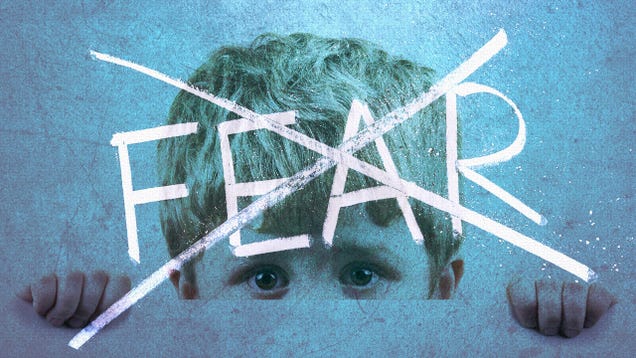
Lisa C. Baker
This post originally appeared on A Fine Parent.
One of the most helpless and frustrating moments as a parent is when our kids have irrational fears, and nothing we say seems to help them cope. It’s perfectly natural for a child to be afraid of the dark, of course, but how can we help them overcome these fears?
It may be something common like the fear of darkness or monsters under the bed. Or something completely out of ordinary like the fear of ants, or everyday sounds, or imaginary little men living under the nightstand.
For my daughter, it was an irrational fear of water. Even a splash on her leg from stepping in a puddle made her scream like she’d been cut with a knife. She ran away from dogs because she was afraid they would lick her. I could only bathe her with a sponge in a bucket in front of the TV to distract her. Once, she punched a one year old in the face because she was so afraid the baby would suck on its fingers and then touch her with wet hands.
I had no idea how to help my daughter overcome her fear of water. What help I was able to offer, I mostly discovered by trial-and-error. But recently, I read a book about childhood anxiety that I wish I’d had when my daughter was younger.
In The Opposite of Worry: The Playful Parenting Approach to Childhood Anxieties and Fears by Lawrence Cohen, I found many of the strategies I stumbled on over the years, as well as others I wish I’d thought to try. Cohen explores ways to help kids overcome worry by replacing it with its opposites: things like connection, mindfulness, courage, playfulness, and confidence.
If you have a child struggling with irrational fears, here’s what you should try.
Validate Your Child‘s Emotions Through Empathy and Calm Confidence
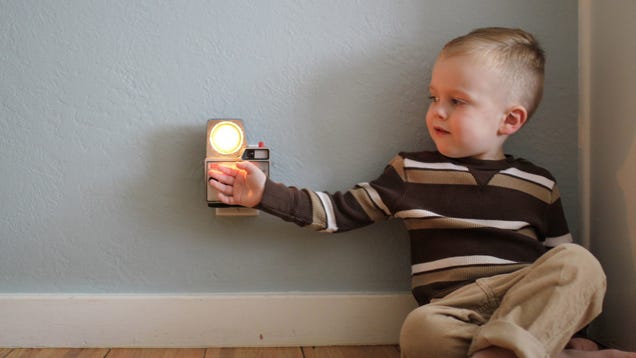
It’s so easy to dismiss a child’s fears. Even if the anxiety is related to something that can be dangerous—you can drown in water, after all—it’s hard not to laugh when a child is terrified of a drop of water on her leg.
In the first few chapters of The Opposite of Worry, Cohen talks about the importance of validating a child’s fears, even if they seem silly. It seems very counter-intuitive—you might think that validating a fear will make your child more scared. In reality though, it will help them process the emotion and move through it.
I was happy to read this, because validating my daughter’s worry is something I’ve always done. Not because her fear made sense to me, but simply because it was clear to me how deep her fear ran. There were times when her screams made me think she’d been seriously injured when she’d only gotten wet. I didn’t know why it felt so scary to her, but I knew she couldn’t help the intensity of her feelings, so I never tried to dismiss them.
According to Cohen, validating your child’s fears helps them connect with you, which is a powerful way to counteract worry. Simply saying something like “It sounds like you’re really scared“can help your child feel more connected and calm. No matter how silly a fear sounds, the emotion is real. Cohen recommends validating the emotion without judging it, with matter-of-fact statements like “You really don’t like the feeling of water on your face. You’re afraid the water will splash on you. That’s really scary.“
But no matter how much I validated my daughter’s emotion and acknowledged her anxiety, her fear of water never lessened. If anything, it got worse. Soon I was washing her hair so rarely that she became known at the playground as “the little girl with the fancy dresses and the messy hair.” We never went for walks in the rain or jumped in puddles. And even though we did go to the pool in the summer, I always let her stay in the shallow water, never going deeper than her knees.
By validating her fear, I was getting caught up in it. I wasn’t able to help her move beyond it, because I was almost as scared as she was. I encouraged her to avoid her fear, and in the long run, that made her more afraid.
Which is why it’s not enough to just validate fear—you also need to project calm confidence.
It’s a hard balance, but you need to follow up validation by demonstrating that you, the parent, are not afraid. Telling your child they shouldn’t be scared will only upset them more, but if they can see your confidence, that will help them start to believe—on a deep, nonverbal level—that there’s nothing to fear.
Cohen recommends asking your child, “Can you look in my eyes and see I’m not afraid?” and then meeting their gaze with calm assurance. After you’ve acknowledged and validated your child’s fear, she might be ready to look at you and feel a different message—the emotional “all-clear” message in your eyes that everything is really okay.
Reduce Your Child‘s Panic With Mindful, Sensory Calming
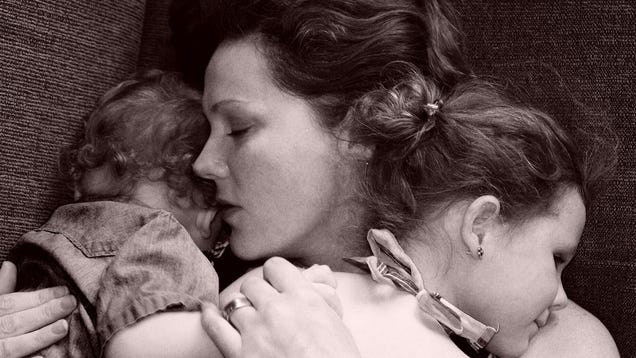
In extreme moments of fear, words are not enough. Your child’s body is reacting as much as his mind: his heart rate speeds up, his breathing gets shallow, his mouth grows dry, his hands and feet get cold. When your child is in a state of panic, validation won’t get you anywhere, and reassurance will get you even less. But sometimes, a physical response will help when your child is beyond words.
Most parents know this instinctively. If your child is terrified and panicking, you automatically comfort him physically—you pick him up, hold him tight, maybe rock him or pat his back.
You can focus your physical comfort so it’s more effective at diffusing panic by counteracting the ways that fear affects your child’s body. The mind-body connection is so powerful, you can change emotions by stopping the body from reacting to those emotions. For example, holding your child’s hands and warming them with your hands will bring the blood back to their hands. This will cause his heart rate and breathing to slow down, because his body will recognize that the need for flight-or-fight is gone.
Once your child is out of the panic zone of fear, physical activities can help him grow more calm and reset his mental state. For example:
- Rhythmic, steady motion like rocking in a chair, swinging in a hammock, or bouncing on a trampoline helps release tension and calm your child’s mind.
- Physical exertion like running or doing jumping jacks can help relaxation.
- Calm, rhythmic activities like pouring sand or doing yoga poses help self-regulation.
For my daughter, these kinds of techniques helped a lot in the moment of fear. When water splashed on her face, physical calming exercises made a big difference. Even though they didn’t do anything to help her get past the mental anxiety long term, calming was good in the short term.
To decrease her long-term anxiety or help her accept the fact that water wasn’t as dangerous as she felt like it was, she needed a challenge—one that I never learned to give her. Luckily, someone else did.
Challenge Your Child to Test the Edge of Fear
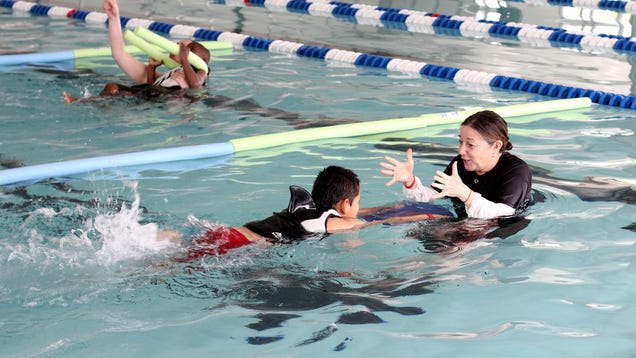
Cohen discusses three reactions that children have to fear: panic, avoidance, and what he calls “feel-and-face.” The third is what happens when a child gets close to the edge of her fear by doing something that’s scary but not so terrifying that she panics. By gradually working up to the edge, she can decrease her fear.
I tried to do this. I encouraged my daughter to just put her chin in the water instead of her whole face, or to rub water on her cheeks just to see what it felt like , but she was rarely willing to try. She just didn’t want to face her fear, and I didn’t know how to motivate her.
Then last summer, we went to the beach with a group of friends. One of the other kids on the trip was a girl a year older than my daughter. The two of them had only played together a few times before, but since they were closer to each other in age than any other kids on the trip, it only took an hour before they were playing like best friends.
Their personalities couldn’t have been more different. My daughter is cautious, careful, thoughtful. Her new friend was rambunctious, outgoing, and active—the kind of kid who leaps first and looks never. And the other girl is also a natural leader, so by the end of the first day, she had my daughter digging in the sand and splashing in the waves in ways that would normally terrify her.
For the first few days, my daughter stuck to her normal cautious behavior in the water. But one evening, she and her friend went out to the pool after dinner. Half an hour later they came running inside, laughing and screeching with excitement. “Mama! Look at me!” my daughter shouted. “Come see what I can do!” I followed her outside to see her jump into the (lukewarm) hot tub. She looked back to make sure I was watching, took a deep breath, and dunked her entire head into the water.
For any other kid, it would have been perfectly normal, but seeing my daughter put her face in the water brought tears to my eyes. I’d been trying for years to persuade her to get her head wet, but it took another child to convince her.
The key was the other girl’s mindset. It was partly that she didn’t feel any my daughter’s anxiety, so my daughter really could look at her and see her projecting absolute confidence. But it was also that she didn’t see worry and anxiety as central to who my daughter was. Unlike me, she didn’t look at my daughter and see a girl who’s afraid of water. She looked at my daughter and saw a playmate for the pool.
That helped my daughter externalize her anxiety—she started to think of it less as something that was part of her and more as something outside her that she could overcome.
Spark Your Child‘s Imagination and Creativity to Challenge Anxious Thoughts
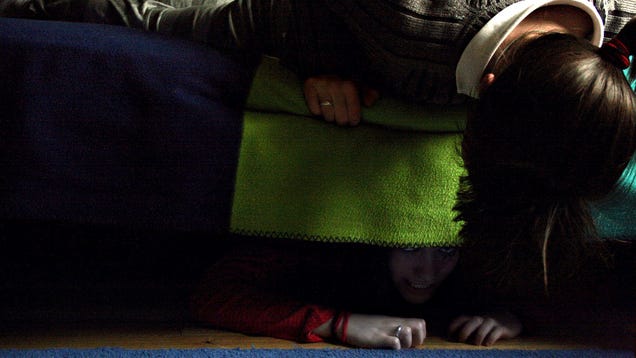
After we got back from that beach trip, I was sure my daughter would finally learn to swim. But it wasn’t that simple. She knew she could put her face in the water, but without her friend nearby to gently push her, she resisted. She had made progress—she was much more willing to get most of her body wet—but she still got upset if her face got splashed.
Cohen talks about the importance of helping childrenfind their own strength and tools to challenge worry. You can conquer anxiety—all the thoughts of “what-if,” as Cohen puts it —by changing your beliefs and adopting thoughts of “what-is,” but it doesn’t help as much when someone else does it, whether that other person is a friend or a parent. Your child has to change her beliefs herself.
For my daughter, the final key to overcoming fear came from her imagination.
It was spring, so summer was coming, but I wasn’t thinking about swimming. I was thinking about summer reading. My daughter was finally old enough to understand chapter books, and I was eager to find a book we could share together—something I would enjoy reading as much as she enjoyed listening. I’d heard about the Emily Windsnap series, a chapter book series about a girl who discovers she’s half mermaid. My daughter loved TV shows about mermaids (H2O was one of her favorites), so I thought she would like Emily. I bought the first ebook, and sure enough, soon she was begging me for “just one more chapter” at all hours of the day. Together, we read vivid descriptions of how Emily felt swimming through the warm ocean, discovering the beauty of the underwater world.
I was thrilled my daughter was enjoying a book so much, but I was even more thrilled when one day she called me into the bathroom during her once-a-week bath. “Look!” she said, and leaned back so her head was almost fully submerged in the water. Her face wasn’t in, but her ears were—something she’d never done voluntarily before.
“You’re putting your head in the water!” I exclaimed.
She smiled up at me. “Do I look like a mermaid?“
Of course she did.
When summer came, I signed her up for swim lessons. By the end of the first lesson, she was putting her face in the water; by the end of the second, she was swimming short distances. Now she begs to go to the pool every day, and she spends most of her time there determinedly practicing her swimming technique.
She already had all the tools she needed to conquer her fear, but the motivation had to come from inside her, and imagination was what sparked it. She had always thought of water as something frightening; Emily Windsnap gave her a new way to think about it—as something beautiful, desirable, and fun instead of something terrifying.
You don’t have to find the perfect book to help your child think of his anxiety a different way (although a great book won’t hurt!). Cohen recommends helping kids conquer their worries through imaginative play. For example, when your child worries about a “what-if” scenario, challenge her by asking, “What if it doesn’t?” Encourage her to finish the story either way. This will help her come up with strategies of her own for handling whatever happens.
Change Your Own Thinking to Match Your Child‘s New Found Confidence
As your child overcomes worry and defeats fear, she’ll develop a new sense of self and a new inner voice—one that’s full of confidence instead of worry. You might find yourself scrambling to keep up.
But it’s essential that you do, because if your child conquers fear, you could be the only thing left to hold her back if you’re not careful.
Today, I couldn’t take my daughter to the pool because of the rain, so she begged me to let her take a bath instead. “I love baths,” she said. “I love water. I just love the way it feels when I’m in the water.“
I tried not to explode with pride as I filled the tub for her. “You know, you didn’t used to love water,” I said. “You used to hate it.“
“Mom!” she groaned, “I never hated water!“
I was so surprised, I protested without thinking. “You did!” I said. “You wouldn’t even let me give you baths when you were a baby.“
“Well, I love water now,” she said with finality. “And I don’t want to talk anymore about how I didn’t used to like it.“
That’s when I realized it was time for me to stop telling stories about her fear.
She was telling herself new stories, and it was time for me to get on board. My daughter has declared a new identity: she’s The Girl Who Loves Water. Her inner voice isn’t talking about anxiety anymore; it’s not reminding her of what-if’s or fears. It’s telling stories about mermaids, and I won’t be the one to question it.
So if you ever meet me, don’t bring up this blog post. And if you see my daughter at the pool swimming like a fish, don’t comment on her courage. This is who she is now. That water anxiety she used to have? That’s so yesterday.
Over the next week, make an effort to look at something your child is afraid of through her eyes. Try to understand why it’s frightening for her and validate her fear before you think about ways to help her move toward confidence.
Leave a Reply